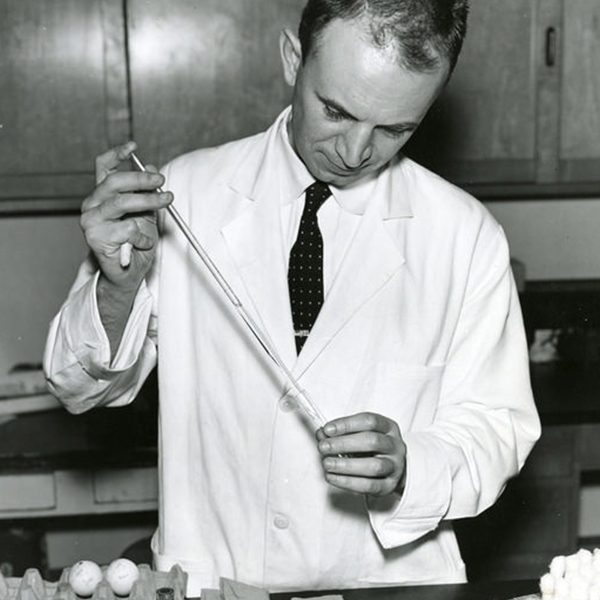
Discovery
Faculty have always cast their nets widely to explore scientific inquiry and probed deeply into disease problems over the years. These men and women established robust research laboratories, designed new treatments, invented better diagnostic tests and developed new disciplines in veterinary medicine.
After determining in the 1950s that animals have different blood types, faculty members built one of the largest blood-typing laboratories in the world. This service, initially for cattle breeders, evolved into highly accurate DNA analysis of many species and now serves clients to establish parentage, detect genetic disease traits and conduct forensic studies when animal evidence is present at a crime scene.
Forward-thinking faculty have applied their veterinary knowledge to pave the way for medical advances. As one early research example, the findings of a virology researcher in the 1940s ultimately contributed to the development of successful attenuated polio vaccines. On the clinical side, a professor, seeking solutions to orthopedic problems in small animals, designed and crafted his own specialized surgical instruments and performed some of the first orthopedic procedures on canine joints. His efforts included shoulder surgery, elbow procedures and one of the first artificial hip resplacements available in veterinary medicine, procedures now routinely taking place in veterinary hospitals.
The legacy of problem solving and creativity continues. Endocrinologists in the new century have accomplished basic research studies on excess sugar consumption, metabolism, obesity and weight-loss surgery that are helping the health profession fight type 2 diabetes, which afflicts more than 21 million Americans. Several studies of the Center for Children's Environmental Health have explained how exposure to toxic compounds may combine with genetic predisposition to alter brain development. The center is the first federally funded entity to perform basic and translational science on autism, and its publications are cited as key discoveries in the field of autism research.
Small animal surgeons introduced minimally-invasive procedures and specialized imaging to treat cancers considered inoperable just a few years ago. Trailblazing procedures include intravascular tumor therapies; intraoperative near-infrared fluorescence imaging; cryoablation; chemoembolization and intra-arterial chemotherapy; and laparoscopic and thoracoscopic surgical procedures to relieve obstructions in the urethra, ureter, colon, esophagus, trachea and blood vessels. Surgeons can reach previously inaccessible locations in the body, and patients recover more quickly with fewer complications.
Whether involved in nutrition, virology or other areas of research, basic and clinical researchers maintain their commitment to improvements in animal health. A founding faculty member investigating the role of sound nutrition in poultry health was the first to discover how Vitamin A prevented a nutritional deficiency. Other nutrition-related discoveries concerned the essential role of taurine in a cat's diet to prevent a fatal heart disease and, more recently, the deadly consequences of mixing melamine and cyanuric acid into pet food.
A founding faculty member developed and applied the first really effective bacterin vaccine against erysipelas, an infection that causes sudden death in turkeys. His method of detecting carriers of Mycoplasma gallisepticum was a vital advance in eradicating the respiratory infection in turkeys and chickens. These and other discoveries also improved the economic outlook of poultry producers.
Unraveling various causes of mastitis, new diagnostic testing methods and an effective vaccine have contributed to California's thriving dairy industry and improvements in cattle health and productivity. From the 1960s to the 1990s, successive faculty members have persisted in finding solutions to this cattle disease.
Regarding diagnostics, faculty have applied modern DNA-based testing methods to detect and control disease. During outbreaks, precision testing that distinguishes between vaccinated animals and those exposed to disease has prevented unneeded depopulation and protected producers from economic losses. In the laboratory, toxicology screens for oleander and other poisonous substances speed diagnosis when time is of the essence, while analytical chemistry assays precisely detect minute traces of drugs or contaminants in animal samples.
UC Davis led the nation’s veterinary schools with $74 million in research funding 2013-2014. What is being accomplished? Many veterinary research findings will translate to human medicine. Recent examples include discovering the genetics of cleft palate in a particular dog breed, which will aid in understanding this human birth defect. A novel melanoma treatment in dogs also holds hope for human patients.
